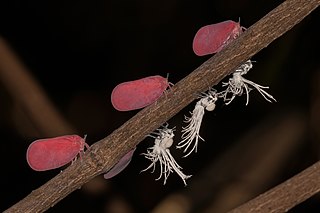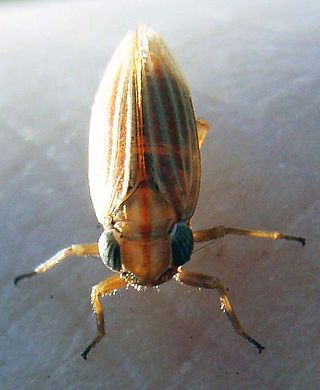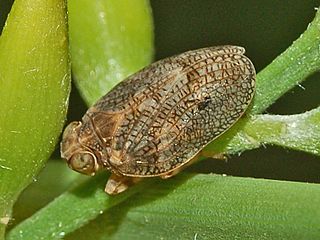
The Auchenorrhyncha suborder of the Hemiptera contains most of the familiar members of what was called the "Homoptera" – groups such as cicadas, leafhoppers, treehoppers, planthoppers, and spittlebugs. The aphids and scale insects are the other well-known "Homoptera", and they are in the suborder Sternorrhyncha.

A planthopper is any insect in the infraorder Fulgoromorpha, in the suborder Auchenorrhyncha, a group exceeding 12,500 described species worldwide. The name comes from their remarkable resemblance to leaves and other plants of their environment and that they often "hop" for quick transportation in a similar way to that of grasshoppers. However, planthoppers generally walk very slowly. Distributed worldwide, all members of this group are plant-feeders, though few are considered pests. Fulgoromorphs are most reliably distinguished from the other Auchenorrhyncha by two features; the bifurcate (Y-shaped) anal vein in the forewing, and the thickened, three-segmented antennae, with a generally round or egg-shaped second segment (pedicel) that bears a fine filamentous arista.

Delphacidae is a family of planthoppers containing about 2000 species, distributed worldwide. Delphacids are separated from other "hoppers" by the prominent spur on the tibia of the hindleg.

Dictyopharidae is a family of planthoppers, related to the Fulgoridae. The family comprises nearly 760 species in more than 150 genera which are grouped into two subfamilies, Dictyopharinae and Orgeriinae.

Hysteropterum is a genus of planthoppers described by Amyot & Serville in 1843, belonging to the family Issidae, subfamily Issinae.

Issidae is a family of planthoppers described by Spinola in 1839, belonging to the order Hemiptera, suborder Auchenorrhyncha superfamily Fulgoroidea.

Issus is a genus of planthoppers belonging to the family Issidae of infraorder Fulgoromorpha of suborder Auchenorrhyncha of order Hemiptera. Like most members of the order Hemiptera they live on phloem sap that they extract with their piercing, sucking mouth parts.

Nogodinidae is a family of planthoppers. They have membranous wings with delicate venation and can be confused with members of other Fulgoroid families such as the Issidae and Tropiduchidae. Some authors treat it as a subfamily of the Issidae.

Caliscelidae is a family of planthoppers, sap-sucking insects that belong to the order Hemiptera, suborder Auchenorrhyncha and superfamily Fulgoroidea. They are somewhat anomalous and have often been included within the family Issidae. Studies made in 2013 of the phylogeny of the Issidae and other groups using molecular techniques support the treatment of the group as a separate family. Sexual dimorphism can be marked. Some members of the family are called piglet bugs due to the shape of their snout. A particularly aberrant genus described in 2011 from India, Formiscurra, has males that resemble ants.

Issus coleoptratus is a species of planthopper belonging to the family Issidae.

Gergithus is a genus of tropical Asian planthoppers in the family Issidae, erected by Carl Stål in 1870. Like all planthoppers, adults feed on plant sap and are capable of escaping by leaping. The genus like other members in the tribe appears somewhat rounded and beetle-like, in some cases, with a mimetic resemblance to ladybird beetles. Species are mostly distributed in the Indomalayan Realm.
Falcidius is a genus of planthoppers in the family Issidae.

Metadelphax is a genus of delphacid planthoppers in the family Delphacidae. There are at least five described species in Metadelphax.

Danepteryx is a genus of tropiduchid planthoppers in the family Tropiduchidae. There are about 6 described species in Danepteryx.

Aplos is a genus of issid planthopper with only one species, Aplos simplex. It can be found in most of the Eastern United States and is now found as an invasive species in Northern Italy and Austria. Aplos simplex was formerly listed under the genus Thionia.

Agalmatium flavescens is a species of planthopper belonging to the family Issidae, subfamily Issinae.

The Hysteropterinae are a subfamily of bugs in the family Issidae, based on the type genus Hysteropterum. Species in 59 genera have been recorded in Europe, Africa, and Asia. One species, Agalmatium bilobum, is now also found as an invasive species in the United States, especially in California.
Waorania is the only genus of issid planthopper in the subtribe Waoraniina. The first two species in the genus were discovered in the forests of Ecuador.
Oronoqua is a genus of issid planthopper in the family Issidae and can be found in the northern Neotropics. The difference in fore and hind wing venations between species of Oronoqua and the other genera in Thioniini led to a subtribe Oronoquina being erected.

Thabena is a genus of planthoppers in the family Issidae. There are about 15 described species in Thabena, found in southeast and temperate Asia.















